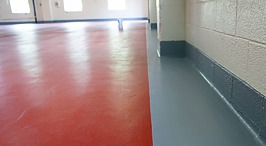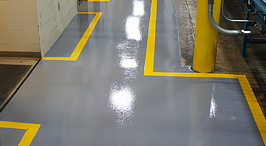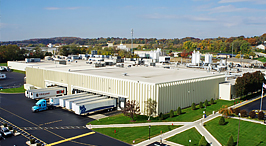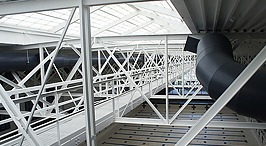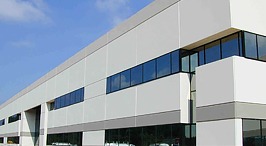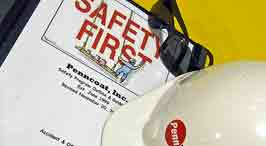Servicing Lancaster, PA for over 25 years

Lancaster County offers more than farmland and agriculture. Within these rural fields are bustling industries that manufacture food, pharmaceuticals, and other products that get shipped throughout the nation.
OUR Lancaster Contracting Services Include
INDUSTRIAL FLOOR COATINGS INSTALLED IN LANCASTER, PA
Lancaster County, Pennsylvania may be best known for its large number of Amish residents. But beyond the tourist attraction, important industries are prevalent, including aquiculture and agribusiness, food processing, pharmaceutical packaging and distribution, and light manufacturing. All of which require industrial painting, commercial painting, and epoxy flooring to pass federal inspections.
LANCASTER’S HISTORY AND ECONOMY
Lancaster was the fourth county established in Pennsylvania, in 1789. During the colonial period it faced challenges since the landscape was different than the original 3 Pennsylvania counties (Philadelphia, Bucks, and Chester), and since the population was the most diverse in the colonies (with people of nearly every national, religious, and ethnic group from northwest Europe, as well as a Native American population). Partly because of these challenges, it served as an example for future counties in Pennsylvania. The original territory was eventually sectioned off to form several other counties, but reached its present size by 1813.
Historically, both farming and manufacturing and commercial painting have been major industries for the region. However, the specific products that are made there have changed somewhat over time, requiring different applications of industrial painting and epoxy flooring.
Lancaster County has a population of 529,600, as of 2013 estimates. It has one city, also called Lancaster, and about 60 smaller municipalities (boroughs and townships). In 2013, the county claimed a Gross Domestic Product (GDP) of $23 billion. Some of the largest industries by GDP in 2013 include manufacturing (over $4 billion) and trade (over $3 billion).
The largest sectors of employment are trade, transportation, and utilities (nearly 20%), education and health services (16%), and manufacturing (13%).
AGRICULTURE AND AGRIBUSINESS
Rural or farm land makes up 75% of the land. The region is known for the quality of its soil and commercial painting, and has been considered the best non-irrigated farmland in the U.S.
In the past, tobacco was grown more extensively. Other crops have since taken its place. Feed grain was also historically grown in the region. Grist mills to process this grain were previously located on many of the county’s rivers and streams – including the Conestoga River (which runs through the middle of Lancaster County) and Susquehanna River (which now forms part of the county’s border).
Today a larger portion of the agricultural business is livestock farming. Dairy farming and poultry/egg farming each make more than $250 million annually, and beef cattle and swine each make about $90 million. In total, livestock accounts for almost 90% of Lancaster’s agricultural revenues. (Much of the crop farming that still occurs may be to support the family or livestock, on family-run farms, so this may not be counted in the area’s GDP.)
The number of farms have been increasing over the last two decades, with 5,657 farms counted in the most recent Agricultural Census (performed every five years by the Department of Agriculture) in 2012. Much of the farming is small, family-run operations – including those owned by the Amish. However, about one-fourth of the county is “effective agricultural zoning” or “agricultural protection zoning” that requires farms of 20 acres or more and routine maintenance from commercial painting contractors or epoxy flooring contractors. This type of zoning can also restrict the types of construction which can be done on properties to buildings used for agricultural purposes.
The agriculture industry accounts for nearly $1 billion in revenue directly each year, but other Lancaster industries also benefit – particularly the manufacturing industry, in which food processing revenue is counted.
LIGHT MANUFACTURING
During the Revolutionary and French and Indian wars, Lancaster County, PA was important as a source of rifles and weaponry, flour and food supplies, uniforms and blankets, and other supplies for the war.
Lancaster’s early major industry was charcoal iron. The region had both ample trees (which were burned to make charcoal) and iron ore (which was processed, using the charcoal, into wrought iron). As more efficient ways of processing iron were introduced this industry was consolidated into larger foundries and relocated. But some metalworking companies still remained.
Other products included furniture, grandfather clocks, silverware, and pewterware. Lancaster was also well known for its production of clothes, shoes, and hats, in the 18th century.
Now, much of the manufacturing that takes place is focused in two industries – pharmaceutical packaging and distribution, and food processing, which requires routine maintenance including commercial painting, industrial painting, and epoxy flooring. Although outside the Greater Philadelphia metropolitan region, it is close enough and has enough transportation infrastructures so that the pharmaceutical industry prominent in Philadelphia has spread into Lancaster County. At least 3 pharmaceutical companies of international importance have facilities in region, demanding quality commercial painting contractors and epoxy floor contractors in Lancaster.
Food manufacturing is influential in the area, and is home to a dairy company which sells its products nationwide and was the fourth-largest producer of ice cream in the country in 2011. It also sells refrigerated iced tea, milk, and other drink products, and is in constant need for maintenance such as commercial painting and epoxy flooring.
There are also several major snack food companies based in Lancaster County. Hard and soft pretzels are popular foods, which were originally made by the area’s German and Pennsylvania Dutch settlers. Lilitz, PA is home to the first commercial pretzel bakery in America, which operates as a historic landmark and gives tours and needs industrial painting. A popular chain of soft pretzel bakeries that can be found in many shopping malls has its headquarters in Lancaster. Another company that sells potato and tortilla chips, cheese curls, popcorn, and pretzels throughout the Mid-Atlantic region was founded in Lancaster.
There are also facilities for many other nationally-known food brands. This includes one of the world’s largest producers of meat and poultry, which is particularly famous for its chicken products. It also includes a bakery famous for its packaged cookies, crackers, and breads.
Other manufacturing companies include ones that make foam cups and containers, pipes and other products for the energy and plumbing industries, and steel for buildings and bridges. All this manufacturing creates demand for industrial painting, commercial painting, and epoxy flooring.
TOURISM IN LANCASTER, PA
Lancaster County, PA is currently home to America’s second-largest Amish population, with approximately 30,000 Amish people (more than 6% of the county’s population). However, it is arguably the most famous place in America’s “Amish Country” and has been featured in numerous movies and books about the Amish and commercial painting.
Amish Country has been touted as a tourist attraction since the 1860s, however, its popularity has often depended on the Amish being featured in popular culture (such as 1955 Broadway musical “Plain and Fancy” and 1985 film “Witness”). Today, many of the tourists arrive for a specific event rather than a general visit.
Historical sites, factory tours, and the county’s 29 covered bridges also bring in tourists to Lancaster County. The county has a dozen historical societies, which operate sites such as the Heritage Center of Lancaster County (a museum of furniture and decorative arts), President James Buchanan’s restored home, and the Historic Rock Ford Plantation.
RETAIL SHOPPING AND TRADE IN LANCASTER, PA
Retail trade brings in more than $1.5 billion to the local economy and commercial painting of Lancaster, and wholesale trade makes up another $1.5 billion.
Some of this trade is in local small businesses that cater to visitors interested in Amish Country and history – quilt shops, furniture makers, antique dealers, general stores, farmers’ markets, and more.
Lancaster County also has two outlet centers, with 60 and 90 stores, respectively, and a mall with more than 170 stores.
OTHER IMPORTANT INDUSTRIES IN LANCASTER COUNTY
Lilitz, PA, in Lancaster County, is also home to three prominent companies in the live events industry, which sell or rent lighting and sound equipment. These companies have provided services for large concert tours, television and broadcast productions, commercial painting, epoxy flooring, and even the Olympic Games.
One of the largest employers of Lancaster County’s workforce is a major television shopping network, which has its headquarters in a nearby county.

